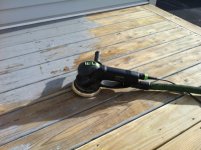nkpaintingvt
Member
- Joined
- Aug 10, 2015
- Messages
- 25
Hello!
I'm soon starting a project that involves sanding down a house with vertical V-groove cedar siding. The flat portions will be cake with my RO and ETS, but the V-grooves present a unique challenge.
I want to maintain their form and end up with crisp lines. The Vs aren't much more than 3/8" deep, and while the board spacing is uniform, I imagine there's some variation in thickness after the weathering. Does anyone have experience using the 90 degree sanding attachment on the LS130 in this context? Worth buying the sander for a whole house? Thoughts or alternatives?
Thanks for reading!
Noah
[attachthumb=2]
I'm soon starting a project that involves sanding down a house with vertical V-groove cedar siding. The flat portions will be cake with my RO and ETS, but the V-grooves present a unique challenge.
I want to maintain their form and end up with crisp lines. The Vs aren't much more than 3/8" deep, and while the board spacing is uniform, I imagine there's some variation in thickness after the weathering. Does anyone have experience using the 90 degree sanding attachment on the LS130 in this context? Worth buying the sander for a whole house? Thoughts or alternatives?
Thanks for reading!
Noah
[attachthumb=2]



